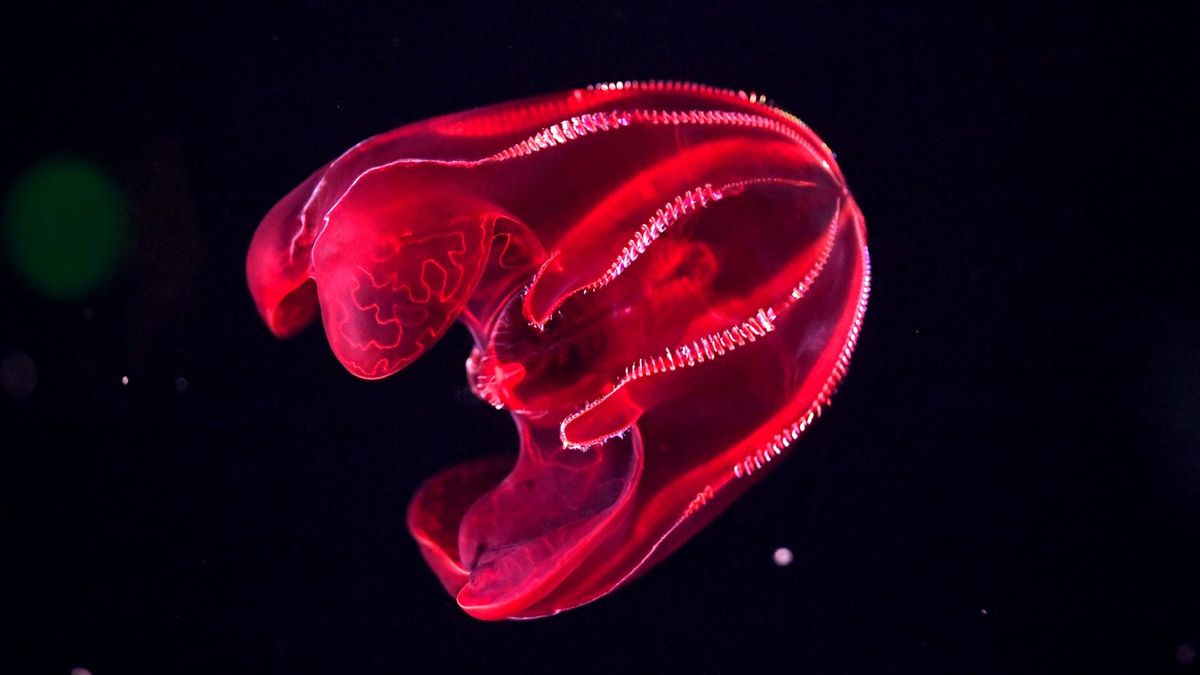What, you don't know a bloody-belly comb jelly when you see one? Neither did we.
David Emery
Published Mar 19, 2023

A Bloody-Belly Comb Jelly swims in its tank at the Monterey Bay Aquarium's new "Into the Deep: Exploring Our Undiscovered Ocean" exhibit in Monterey, Calif.
(Image Via Getty Images)
An oft-shared video clip of remotely-operated vehicle (ROV) deep-sea footage of what is described by social media users as an "alien-looking creature" or "unidentified transforming deep sea creature." Here is the clip as it appeared on Twitter on March 11, 2023:
Newsweek reported on the fascinating characteristics of the bloody-belly comb jelly in October 2022:
The aptly named bloody-belly comb jelly (Lampocteis cruentiventer) has been spotted in waters ranging from 984 to 9,842 feet deep, with most observations occurring at depths of around 1,640 feet, George Matsumoto, a senior education and research specialist, at the Monterey Bay Aquarium Research Institute (MBARI) in California, told Newsweek.
This species is found throughout the Pacific Ocean basin and has been seen in the Atlantic Ocean basin as well. "We see them on most of our ROV [remotely operated underwater vehicle] dives so I would say that they are relatively common in the Eastern Pacific," Matsumoto said.
The moniker "bloody-belly" was inspired by the reddish tint of the translucent comb jelly's body. Comb jellies eat smaller creatures that are sometimes bioluminescent (meaning they produce their own light), so scientists conjecture that the evolutionary purpose of the coloring is to hide the contents of the red-belly comb jelly's stomach from predators. This can cause the comb jelly itself to give off a red glow, though in the deep sea that isn't a problem. From Newsweek again:
While it may seem like a glowing red belly might not be such a good idea if you are trying to stay hidden, there is a reason behind the evolution of this trait. Red is the first wavelength of light absorbed as you descend into the deep sea. So in these regions, bloody-belly comb jellies appear black, rendering them virtually invisible given the darkness of their surroundings.
Visit the website of the Monterey Bay Aquarium Research Institute (MBARI) to learn more.
David Emery is a Portland-based writer and editor with 25 years of experience fact-checking rumors, hoaxes, and contemporary legends.
An oft-shared video clip of remotely-operated vehicle (ROV) deep-sea footage of what is described by social media users as an "alien-looking creature" or "unidentified transforming deep sea creature." Here is the clip as it appeared on Twitter on March 11, 2023:
However, this elegant, shape-shifting animal is neither unidentified nor an alien. Specimens are often photographed during deep-ocean ROV missions, and the species is known as a bloody-belly comb jelly, or Lampocteis cruentiventer, according to the Monterey Bay Aquarium:
Newsweek reported on the fascinating characteristics of the bloody-belly comb jelly in October 2022:
The aptly named bloody-belly comb jelly (Lampocteis cruentiventer) has been spotted in waters ranging from 984 to 9,842 feet deep, with most observations occurring at depths of around 1,640 feet, George Matsumoto, a senior education and research specialist, at the Monterey Bay Aquarium Research Institute (MBARI) in California, told Newsweek.
This species is found throughout the Pacific Ocean basin and has been seen in the Atlantic Ocean basin as well. "We see them on most of our ROV [remotely operated underwater vehicle] dives so I would say that they are relatively common in the Eastern Pacific," Matsumoto said.
The moniker "bloody-belly" was inspired by the reddish tint of the translucent comb jelly's body. Comb jellies eat smaller creatures that are sometimes bioluminescent (meaning they produce their own light), so scientists conjecture that the evolutionary purpose of the coloring is to hide the contents of the red-belly comb jelly's stomach from predators. This can cause the comb jelly itself to give off a red glow, though in the deep sea that isn't a problem. From Newsweek again:
While it may seem like a glowing red belly might not be such a good idea if you are trying to stay hidden, there is a reason behind the evolution of this trait. Red is the first wavelength of light absorbed as you descend into the deep sea. So in these regions, bloody-belly comb jellies appear black, rendering them virtually invisible given the darkness of their surroundings.
Visit the website of the Monterey Bay Aquarium Research Institute (MBARI) to learn more.
David Emery is a Portland-based writer and editor with 25 years of experience fact-checking rumors, hoaxes, and contemporary legends.
No comments:
Post a Comment